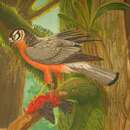Hawaiian harrier Other names: Wood harrier or Mime harrierExtinctOne of dozens of original paintings housed at the Smithsonian Institution (Washington, D.C.) by Julian P. Hume.On a visit to the Smithsonian in October 2003, Helen James & Storrs Olson showed us several wonderful paintings of an artist depiction of extinct Hawaiian subfossil avifauna. The truth is, however, that no one alive really knows what they actually looked like. But, Julian does a great job of bringing the bones to life with his world class paintings!Helen & Storrs allowed me to take photographs with the condition that they not be shown publicly until published. The photos were finally published in "Extinct Birds of Hawaii" (2016) by Michael Walther and generously illustrated by Julian P. Hume.Th Hawaiian harrier (Circus dossenus), now extinct, was a small Accipter-like raptor with short, broad wings enabling it to fly through forests to capture its bird and insect prey. In this painting the victim is iiwi or scarlet honeycreeper (Drepanis coccinea), which is still extant and more of the more "common" native birds though it's numbers are declining and is now considered as Vulnerable (IUCN).Subfossils of the Hawaiian harrier have been found in sinkholes at Barber's Point, Oahu and in sand dunes at Moomomi, Molokai.Another photo of Hawaiian harrier
www.flickr.com/photos/dweickhoff/30644131875/in/photostream/EtymologyThe genus Circus, derived from the Ancient Greek kirkos, referring to a bird of prey named for its circling flight (kirkos, "circle"), probably the hen harrier.For the specific epithet, James & Olson named it dossenus, explaining the name as follows: Latin, dossenus, a clown or jester, without which one cannot have a circus; especially applicable here because the species initially fooled us as to its generic placement. Helen working
www.flickr.com/photos/dweickhoff/30645181485/in/photostream/Helen & Storrs
www.flickr.com/photos/dweickhoff/30012540014/in/photostream/


